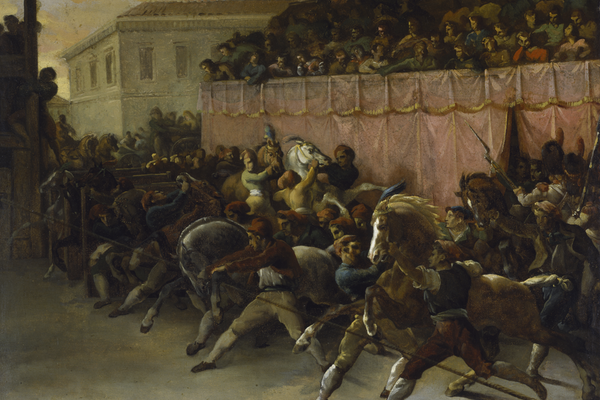For Derby Day, a Note of Caution About Horses and "Races"

Riderless Racers at Rome, Théodore Géricault, 1817
With the Kentucky Derby just around the corner, horse lovers and the uninitiated alike prepare their hats, mint juleps, and bets for what is widely known as “the most exciting two minutes in sports.” And with the puff of dust unleashed by the horses’ hooves, all the messiness of an old tradition with a deep history is kicked up once again.
Scandals abound, fueling the drama of the race. At only three years of age, the horses are young and their risk of injury is high, as the world saw when the filly Eight Belles was euthanized after she broke both front ankles following a second-place finish in 2008. Testing has sought to root out the use of drugs like the steroid that helped lead Medina Spirit to victory in 2021. That is without factoring in the gambling along with the social dynamics of wealth at play as 150,000 fans gather to watch the thoroughbreds round the track.
But another thread is even more nefarious. We find it in places like the race’s official website that celebrates that “The first step on the ‘Road to the Kentucky Derby’… is the breeding shed.” Breeding racehorses is an elaborate, expensive affair complete with pedigree charts and contracts. For registration with the US Jockey Club, a Thoroughbred must be conceived through “live cover,” not embryo transfer, cloning, or artificial insemination. That means the mare (the female horse) must be brought to the stallion (the male) when she comes into heat, and stallions might mate with up to three mares a day. Elite horses, then, are both born and made as so much work goes into both their breeding and training.
Horse racing activates “best in breed” thinking. Pursuing the best, most perfectly bred animal is not a new concept. It has its roots in the Renaissance, another heyday for horse racing, and contributed to the evolution of the idea of race.
Throughout the Italian Renaissance, the patrons of Leonardo da Vinci and Galileo Galilei spent a fortune on horses alongside artists and intellectuals. Their fascination with sketching out the perfect proportions of buildings and humanity, exemplified in the Vitruvian man, extended to creating perfect horses.
For exorbitant sums, they imported animals from around Europe and the Mediterranean in pursuit of the best characteristics of each, and the political ties that came from getting to know their breeders. Arabian horses were famous for their agility. Turkish horses were steady over long distances. North African horses were known for their sprinting. Once brought to Italy, these animals would be bred with European horses in pursuit of the best combinations for riding, carriage driving, and, of course, racing. Cities would grind to a halt as everyone watched the palio horse races that ran through the central piazza, showcasing which noble family had managed to breed the best animals.
The irony is, though, that racing bred race. These projects to create the best horses popularized a word invented in the Renaissance: “race.” Owners, breeders, and trainers all referred to the horses they raised as “razze dei cavalli.” While the modern English term “race” is, according to Marriam-Webster’s Dictionary, chiefly a word for “any one of the groups that humans are often divided into based on physical traits regarded as common among people of shared ancestry,” the word began with a meaning akin to our word “breed.” In the Renaissance, “race” meant a stock (as in livestock), or a population that had been carefully bred. It didn’t emphasize physical differences; instead, it called attention to the work of selection and training.
However, as European empires expanded into overseas territories, they brought this new term “race” and used it to describe both humans and animals. In these hierarchal, colonial systems, it became a term to denote fixed, physical differences in humans rather than temporary reproductive work of breeding in animals.
The slipperiness around breeding as innate and trained continue to rear up. Even now, attending a horse race carries the connotation of good breeding. That’s what at stake in the joke in My Fair Lady when Eliza Doolittle, the carefully educated protégé taught upper-class English to raise her out of poverty, makes the fateful error of shouting at her horse to run a touch faster. No matter how perfect her hat, accent, and company had been, something about her true background slipped out in the thrill of the race.
So, on May 6, when we root for the aptly named Angel of Empire and the other colts and fillies who make it to the Derby, we are slipping into a much older tradition. By admiring their rippling coats and eye-popping speed, we are celebrating animals that have been crafted with human intervention to attain quasi-eugenic ideals.